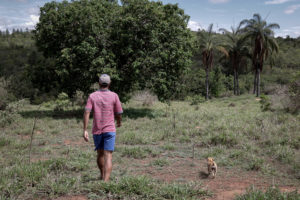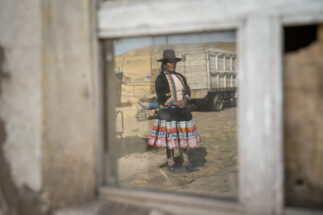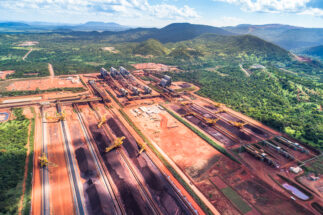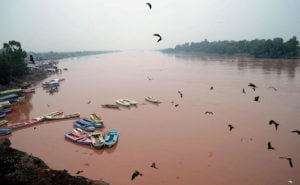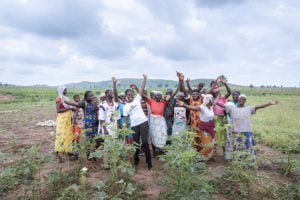A long-running dispute continues to rage between companies trying to unblock one of Brazil’s biggest mining projects and traditional communities who fear irreversible impacts on their ancestral territory as a result of the works.
The mining company Sul Americana de Metais (SAM), a subsidiary of Hong Kong-based private investment company Honbridge Holdings, and Lotus Brasil Comércio e Logística, a logistics firm linked to SAM, plan to exploit 27.5 million tonnes of iron ore annually in the region of Vale das Cancelas, in the south-eastern state of Minas Gerais. A large part of this production is likely to ship to China, the company says.
SAM told Diálogo Chino that it was looking for new partners to help get the project off the ground. In addition to the mine and other major works, the project would have the largest tailings dam in the country, with a capacity of 1.3 billion cubic metres – larger than the 62-million-cubic-metre dam that broke in Mariana in 2015, flooding 35 municipalities. The companies behind the new project are also seeking approval for an environmental licence for the mining complex, which has proven controversial.
However, standing in their way are around 2,230 families inhabiting the region, who say they will not accept being relocated or seeing their territory devastated. For this reason, local leaders and civil organisations have just concluded a protocol for free, prior and informed consultation with the communities about the project, as provided for in the International Labour Organisation’s Convention 169 – the Indigenous and Tribal Peoples Convention, 1989 – to which Brazil is a signatory.
The Margarida Alves Collective, a grassroots group of lawyers providing legal advice to social justice movements, explains that this consultation is a right of the communities, but the appropriate process had not been followed in the Vale das Cancelas – which they describe as a common reality in the country. “There are a number of projects being licensed throughout Brazil without the communities being included and respected,” says Layza Santos, one of the collective’s lawyers.
The aim now is to take the case to the authorities in search of legal protection against the megaproject. “For our part, we’re going to fight it as long as we have the strength,” Marlene Ribeiro, a local leader and president of the Intermunicipal Council of Traditional Geraizeiro and Vacariano Territories, tells Diálogo Chino. “We’re not going to let them put an end to everything.”
The council estimates that the works will require the forced relocation of at least 3,000 geraizeiros and vacarianos, peoples who have lived in the region for seven generations, and that the project poses a threat to food crops and traditional ways of life. The peoples occupy the plateaus of inland Brazil, where they raise cattle and other animals, in open and collective areas, over vast areas from the Cerrado savannah to the shrublands of the Caatinga biome.
Land insecurity
Like the majority of traditional populations in Brazil, the communities of the Vale das Cancelas are still seeking titles to the land that has been recognised as belonging to them.
In 2018, the 73 geraizeiro communities that inhabit the region were finally recognised by the State Commission for Traditional Peoples and Communities. But the state has been slow to allocate territory to the communities and formalise the land titles – its role under the law. For decades, the government’s delay has fuelled violent conflicts in the region.
According to community leaders, another important step in the process was recently completed: an anthropological report drawn up by the Federal University of Minas Gerais, with the active participation of the local population. The communities hope that the document will speed up the long-awaited regularisation of land ownership and the rightful recognition of the land deeds as theirs.
Since the 1970s, these communities, based in the north of Minas Gerais, have suffered from the advance of eucalyptus monoculture and land grabbing by companies and landowners, according to the Pastoral Land Commission (CPT), an organisation that monitors rural conflicts in Brazil.
In recent years, they have been on the receiving end of attempts to build goodwill by the SAM mining company, which in 2008 won authorisation from the federal government to begin mining surveys in the region. The Block 8 project, as it is called, is expected to cost 7.25 billion reais (US$1.464 billion).
“SAM is hungry to mine here,” said Ribeiro. “Its employees drive around in pick-up trucks all the time, knocking on the doors of communities with documents of dubious origin and trying to win the trust of the families who will have to be removed. At Christmas, they handed out panettone to the adults and sweets to the children.”
By 2019, the company had already spent the equivalent of almost US$148 million on mining research, engineering projects and operating expenses, but it is still struggling with the environmental licensing required for the project to progress.
The planned mining complex would comprise an open-pit mine, three water dams, pipelines, a power transmission line, a treatment plant and two tailings dams, one of which would be the largest in the country.
The watery pulp of the ore, the usual form in which the commodity is transported, would be moved via a 481-kilometre pipeline – one of the longest in the world, if approved and completed. The intention is to transport the commodity from Minas Gerais to the port of Ilhéus, in the north-eastern state of Bahia – crossing 21 municipalities and the territories of other communities – to the international market.
The first version of the project was rejected by IBAMA, the federal environmental protection agency, due to its enormous size and potential environmental impacts. In 2017, SAM opened Lotus Brasil Comércio e Logística and changed its strategy: the two companies are now applying for separate licences for the pipeline and the mine.
Licensing for the project is currently the responsibility of the Minas Gerais State Environmental Foundation (FEAM), which told Diálogo Chino that the mine is in the preliminary analysis phase, the first stage of the process. SAM declined an interview, but said in a statement that it was assessing FEAM’s analysis, which included a request for new technical studies.
Mining always comes before usAdair de Almeida, community leader in Vale das Cancelas
In the case of the pipeline, FEAM still needs to discuss and formalise technical cooperation over the environmental impact study with INEMA, its counterpart in Bahia state, since the pipeline passes through both states. Lotus said in a statement that it is waiting for this cooperation agreement in order to proceed with the project, and that it plans to produce green hydrogen from the treatment of waste generated by the transport of ore.
The companies continue to present the project to government bodies in Minas Gerais and Bahia, but did not mention in their statement any possible negative impacts from the works on farming communities.
Meanwhile, community leader Adair de Almeida is critical of the fact that those involved have excluded the families from the process. “The villagers are out of the picture,” he says. “Economic interests are above all else, and mining always comes before us.”
Ecological heritage under threat
A transitional region between the Cerrado and the Caatinga in the north-east, Vale das Cancelas has unique ecosystems such as the rocky campo rupestre grasslands, dozens of endangered plant species and deposits of high-quality diamonds. On the plateaus of these landscapes, geraizeiros plant a range of medicinal plants and fruit trees such as pequi and buriti, and also raise animals.
For Almeida, the Cerrado, due to its ecological and social importance, should not host a development of the scale proposed by SAM and Lotus: “Licensing these projects would be absurd. It’s a devastation project.”
Block 8 could also reportedly impact 138 springs, suppressing 57 of them in a semi-arid region that already suffers from water scarcity due to natural conditions, climate change that brings severe droughts, and the long-term impact of eucalyptus cultivation to supply charcoal production. In the Jequitinhonha river basin, where the project would be built, several rivers that were perennial have become intermittent; streams have dried up in the region inhabited by the geraizeiros.
Despite the worrying situation, the National Water and Basic Sanitation Agency has granted SAM a licence to collect 51 million cubic metres a year – enough to supply a city of 400,000 people in the same period of time – from a dam on the Jequitinhonha River, which gives its name to one of the most vulnerable regions in Minas Gerais.
This is a region “impoverished by misguided public policies,” says Felipe Soares, an educator, activist and member of the Movement of People Affected by Dams (MAB). “None of the big projects that have arrived have brought ‘development’,” he notes, suggesting that strengthening family farming and the bioeconomy would be a more coherent approach to regional development.
This large volume of water will be used both to wash the ore and to transport its watery pulp through the pipeline to the port in Bahia. The geraizeiros fear that if the project receives approval to operate, there may be water for mining, but not for supplying families and their fields.
“Last year, we were in a state of emergency for six months because of drought,” Almeida recalls. This year is no different: the municipalities of the Vale das Cancelas continue to be affected by severe drought, according to an update from the Minas Gerais Civil Defence.
China and iron ore
China is the world’s largest consumer of iron ore, largely destined for its huge steel industry that accounts for over half of all global production. Brazil is the second-largest exporter of the product, behind Australia, with China its biggest customer.
The Asian country is also the world’s third largest producer of the commodity, but its deposits are mostly of a low grade. In addition, its mines are being depleted, and the cost of production on Chinese soil is high. Recent years have seen strategic moves by its government to back investments in iron ore projects around the world, and the creation of a centralised, state-owned iron ore buying agency in 2022.
Kelly Ferreira, a member of Observa China, an independent network of China-focused professionals and researchers, says the Chinese government will hope to see new ventures such as that in Vale das Cancelas proceed. “Diversifying suppliers of strategic materials is a way of guaranteeing supply, avoiding dependence on a single country. We are rich in resources and have good relations with China, so interest in Brazil is natural.”
While SAM and Hong Kong-based Honbridge are private ventures, not backed by Chinese state agencies, the potential output from Vale das Cancelas could be largely destined for the Chinese market.
But Ferreira emphasises that projects like Block 8 need to be viable for all parties – traditional communities, and investors interested in one of the most important minerals for the Chinese economy. “Negotiating areas of lesser environmental relevance for such exploitation could be a more intelligent solution,” she concludes.
